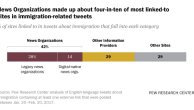Summary of Findings

As the public continues to closely track news about the environmental disaster unfolding in the Gulf of Mexico, few Americans say news organization are giving the oil leak too much coverage.
The Gulf oil leak once again topped both public interest and media coverage last week, though the percent following the story very closely dropped to 43% from 57% the week of July 1-5. Still, 45% say they followed this news more closely than any other major story. Just 13% say they followed the next ranking story – the U.S. government’s legal challenge to Arizona’s new immigration law – most closely, according to the latest weekly News Interest Index conducted July 8-11 among 1,001 adults by the Pew Research Center for the People & the Press.
News about the oil spill accounted for 15% of coverage, more than double the next top story but far below the 44% devoted to the leak the week of June 14, according to a separate analysis by the Pew Research Center’s Project for Excellence in Journalism (PEJ). The percentage of coverage devoted to the spill declined in subsequent weeks as the media also focused on other major stories – such as the economy and the war in Afghanistan.

A majority (53%) now says that news organizations are giving the right amount of coverage to the oil leak, matching the number that said this last month. Just 15% say the story is getting too much coverage, while about a quarter (27%) say it is getting too little. Those numbers are little changed from May or June.
The public takes a more critical view of the amount of coverage devoted to two other stories last week. Seven-in-ten (71%) say the sentencing of actress Lindsay Lohan to jail time for probation violations received too much coverage; 61% say the same about coverage of NBA-star LeBron James’ televised announcement that he would join the Miami Heat next season.
Leak Still Dominates Public’s Interest

Despite the decline in the percentage saying they followed oil leak news very closely, no other story comes close when people are asked which story they followed most closely. That has been the case each week since the start of May, shortly after the April 20 oil rig-explosion that sent oil spewing into the Gulf from an underwater well.
Though 30% say they followed news about the immigration lawsuit very closely, just 13% say this was the news they followed most closely. News about the immigration debate accounted for 4% of the newshole examined by PEJ.
More than a third (36%) say they followed news about the economy very closely, while 11% say this was the news they followed most closely. Last week, news about the economy accounted for 7% of coverage.
About a quarter (23%) say they followed news about the situation in Afghanistan very closely. That’s down slightly from the 29% that said they were following Afghanistan developments very closely one week earlier – shortly after the ouster of Gen. Stanley McChrystal as commander of U.S. forces there. Just 5% say this was the news they followed most closely last week. News about Afghanistan accounted for 6% of coverage.

Another 22% say they followed news about the heat wave that hit the east and the south very closely; 4% say this was the story they followed most closely. News about the heat wave accounted for 4% of coverage.
Just 13% say they very closely followed news about the exchange of suspected spies between the United States and Russia; 1% say this was the story they followed most closely. The spy story accounted for 6% of coverage.
LeBron James’ Big Decision Widely Known
The public was much more aware last week of news involving two well-known celebrities than reports about visits to the United States by two foreign leaders. Four-in-ten (41%) say they heard a lot about LeBron James’ decision – announced live on ESPN on July 8 – to leave the Cleveland Cavaliers and join the Miami Heat basketball team. Another 27% say they heard a little about this. About three-in-ten (31%) say they heard nothing at all. Almost half of men (49%) say they heard a lot about James’ announcement, compared with 33% of women.

Just more than a quarter (27%) say they heard a lot about Lindsay Lohan getting sentenced to 90 days in jail for violating the terms of her probation. More than four-in-ten (42%) say they heard a little about this and 30% say they heard nothing at all. More women (31%) say they heard a lot about this than men (23%). Those 65 and older, meanwhile, were just as likely as those 18-29 to say they had heard a lot about Lohan’s sentencing (24% vs. 23%).
Visits to the U.S. by Israeli Prime Minister Benjamin Netanyahu and England’s Queen Elizabeth were less widely known. Just 13% say they heard a lot about Netanyahu’s trip, which included a meeting with President Obama in Washington. About a third (35%) heard a little about the visit, but 52% say they heard nothing at all.
Just 9% heard a lot about the queen’s visit, her first to New York since 1976, 47% heard a little about this and 43% say they heard nothing at all.
Too Much Coverage for Lindsay and LeBron
Large majorities say news organizations gave too much coverage last week to Lohan’s legal woes (71%) and James’ announcement (61%), but majorities say the press gave the right amount of coverage to the heat wave that hit eastern and southern states (58%) and to the continuing oil leak in the Gulf of Mexico (53%).
While women were more likely than men to have heard a lot about Lohan’s troubles, the sexes were equally likely to say the story got too much coverage: 73% of men say this and 70% of women. On the other hand, men were more likely than women both to have heard a lot about James’ move and to say that the story got too much coverage (68% vs. 55%).

Opinions about the amount of coverage given to the economy and the situation in Afghanistan are more divided. About four-in-ten (42%) say news organizations gave the right amount of coverage to the economy while 45% say they gave the economy too little coverage. Just 8% say they gave the economy too much coverage. In two surveys earlier this year – in February and April – the balance tilted more toward the right amount of coverage. In each, 46% said news organizations were giving the right amount of coverage to the economy and 34% said they were giving it too little coverage.
Currently, 47% say news organizations are giving too little coverage to the situation and events in Afghanistan, 40% say they are giving the right amount of coverage and 6% say too little coverage. In October 2009, 46% said right amount, 39% said too little and 11% said too much coverage.
These findings are based on the most recent installment of the weekly News Interest Index, an ongoing project of the Pew Research Center for the People & the Press. The index, building on the Center’s longstanding research into public attentiveness to major news stories, examines news interest as it relates to the news media’s coverage. The weekly survey is conducted in conjunction with The Project for Excellence in Journalism’s News Coverage Index, which monitors the news reported by major newspaper, television, radio and online news outlets on an ongoing basis. In the most recent week, data relating to news coverage were collected July 5-11, and survey data measuring public interest in the top news stories of the week were collected July 8-11, from a nationally representative sample of 1,001 adults.
About the News Interest Index
The News Interest Index is a weekly survey conducted by the Pew Research Center for the People & the Press aimed at gauging the public’s interest in and reaction to major news events. This project has been undertaken in conjunction with the Project for Excellence in Journalism’s News Coverage Index, an ongoing content analysis of the news. The News Coverage Index catalogues the news from top news organizations across five major sectors of the media: newspapers, network television, cable television, radio and the internet. Each week (from Monday through Sunday) PEJ compiles this data to identify the top stories for the week. (For more information about the Project for Excellence in Journalism’s News Coverage Index, go to www.pewresearch.org/pewresearch-org/journalism.) The News Interest Index survey collects data from Friday through Monday to gauge public interest in the most covered stories of the week.
Results for this survey are based on telephone interviews conducted under the direction of Princeton Survey Research Associates International among a national sample of 1,001 adults living in the continental United States, 18 years of age or older, from July 8-11, 2010 (670 respondents were interviewed on a landline telephone, and 331 were interviewed on a cell phone, including 123 who had no landline telephone). Both the landline and cell phone samples were provided by Survey Sampling International. Interviews were conducted in English.
The combined landline and cell phone sample are weighted using an iterative technique that matches gender, age, education, race, Hispanic origin, region, and population density to parameters from the March 2009 Census Bureau’s Current Population Survey. The sample is also weighted to match current patterns of telephone status based on extrapolations from the 2009 National Health Interview Survey. The weighting procedure also accounts for the fact that respondents with both landline and cell phones have a greater probability of being included in the combined sample and adjusts for household size within the landline sample. Sampling errors and statistical tests of significance take into account the effect of weighting. The following table shows the error attributable to sampling that would be expected at the 95% level of confidence for different groups in the survey:

In addition to sampling error, one should bear in mind that question wording and practical difficulties in conducting surveys can introduce error or bias into the findings of opinion polls.




